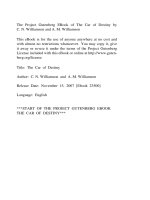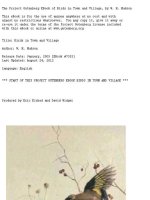The Project Gutenberg EBook of Darwiniana, by Thomas Henry Huxley ppt
Bạn đang xem bản rút gọn của tài liệu. Xem và tải ngay bản đầy đủ của tài liệu tại đây (1.76 MB, 988 trang )
The Project Gutenberg EBook of
Darwiniana, by Thomas Henry Huxley
Copyright laws are changing all over the
world. Be sure to check the copyright
laws for your country before downloading
or redistributing this or any other Project
Gutenberg eBook.
This header should be the first thing seen
when viewing this Project Gutenberg file.
Please do not remove it. Do not change or
edit the header without written
permission.
Please read the "legal small print," and
other information about the eBook and
Project Gutenberg at the bottom of this
file. Included is important information
about your specific rights and restrictions
in how the file may be used. You can also
find out about how to make a donation to
Project Gutenberg, and how to get
involved.
**Welcome To The World of Free Plain
Vanilla Electronic Texts**
**eBooks Readable By Both Humans and
By Computers, Since 1971**
*****These eBooks Were Prepared By
Thousands of Volunteers!*****
Title: Darwiniana
Author: Thomas Henry Huxley
Release Date: November, 2004 [EBook
#6919] [This file was first posted on
February 10, 2003]
Edition: 10
Language: English
*** START OF THE PROJECT
GUTENBERG EBOOK, DARWINIANA
***
Branko Collin, Carlo Traverso, Charles
Franks and the Distributed
Proofreading Team.
This file was produced from images
generously made available by the
Bibliothèque nationale de France
(BnF/Gallica) at .
Thomas Henry Huxley
Collected Essays
(1893-1894)
Vol. II
Darwiniana
(Edition: published in 1893)
PREFACE
I have entitled this volume "Darwiniana"
because the pieces republished in it either
treat of the ancient doctrine of Evolution,
rehabilitated and placed upon a sound
scientific foundation, since and in
consequence of, the publication of the
"Origin of Species;" or they attempt to
meet the more weighty of the unsparing
criticisms with which that great work was
visited for several years after its
appearance; or they record the impression
left by the personality of Mr. Darwin on
one who had the privilege and the
happiness of enjoying his friendship for
some thirty years; or they endeavour to
sum up his work and indicate its enduring
influence on the course of scientific
thought.
Those who take the trouble to read the
first two essays, published in 1859 and
1860, will, I think, do me the justice to
admit that my zeal to secure fair play for
Mr. Darwin, did not drive me into the
position of a mere advocate; and that,
while doing justice to the greatness of the
argument I did not fail to indicate its weak
points. I have never seen any reason for
departing from the position which I took
up in these two essays; and the assertion
which I sometimes meet with nowadays,
that I have "recanted" or changed my
opinions about Mr. Darwin's views, is
quite unintelligible to me.
As I have said in the seventh essay, the
fact of evolution is to my mind sufficiently
evidenced by palaeontology; and I remain
of the opinion expressed in the second,
that until selective breeding is definitely
proved to give rise to varieties infertile
with one another, the logical foundation of
the theory of natural selection is
incomplete. We still remain very much in
the dark about the causes of variation; the
apparent inheritance of acquired
characters in some cases; and the struggle
for existence within the organism, which
probably lies at the bottom of both of
these phenomena.
Some apology is due to the reader for the
reproduction of the "Lectures to Working
Men" in their original state. They were
taken down in shorthand by Mr. J. Aldous
Mays, who requested me to allow him to
print them. I was very much pressed with
work at the time; and, as I could not revise
the reports, which I imagined, moreover,
would be of little or no interest to any but
my auditors, I stipulated that a notice
should be prefixed to that effect. This was
done; but it did not prevent a considerable
diffusion of the little book in this country
and in the United States, nor its translation
into more than one foreign language.
Moreover Mr. Darwin often urged me to
revise and expand the lectures into a
systematic popular exposition of the
topics of which they treat. I have more
than once set about the task: but the
proverb about spoiling a horn and not
making a spoon, is particularly applicable
to attempts to remodel a piece of work
which may have served its immediate
purpose well enough.
So I have reprinted the lectures as they
stand, with all their imperfections on their
heads. It would seem that many people
must have found them useful thirty years
ago; and, though the sixties appear now to
be reckoned by many of the rising
generation as a part of the dark ages, I am
not without some grounds for suspecting
that there yet remains a fair sprinkling
even of "philosophic thinkers" to whom it
may be a profitable, perhaps even a novel,
task to descend from the heights of
speculation and go over the A B C of the
great biological problem as it was set
before a body of shrewd artisans at that
remote epoch.
T. H. H.
Hodeslea, Eastbourne, April 7th, 1893.
CONTENTS
I THE DARWINIAN HYPOTHESIS
[1859]
II THE ORIGIN OF SPECIES [1860]
III CRITICISM ON "THE ORIGIN OF
SPECIES" [1864]
IV THE GENEALOGY OF ANIMALS [1869]
V MR. DARWIN'S CRITICS [1871]
VI EVOLUTION IN BIOLOGY [1878]
VII THE COMING OF AGE OF "THE
ORIGIN OF SPECIES" [1880]
VIII CHARLES DARWIN [1882]
IX THE DARWIN MEMORIAL [1885]
X OBITUARY [1888]
XI SIX LECTURES TO WORKING MEN
"ON OUR KNOWLEDGE OF THE CAUSES
OF THE PHENOMENA OF ORGANIC
NATURE" [1863]
I
THE DARWINIAN HYPOTHESIS
[1859]
The hypothesis of which the present work
of Mr. Darwin is but the preliminary
outline, may be stated in his own language
as follows:— "Species originated by
means of natural selection, or through the
preservation of the favoured races in the
struggle for life." To render this thesis
intelligible, it is necessary to interpret its
terms. In the first place, what is a species?
The question is a simple one, but the right
answer to it is hard to find, even if we
appeal to those who should know most
about it. It is all those animals or plants
which have descended from a single pair
of parents; it is the smallest distinctly
definable group of living organisms; it is
an eternal and immutable entity; it is a
mere abstraction of the human intellect
having no existence in nature. Such are a
few of the significations attached to this
simple word which may be culled from
authoritative sources; and if, leaving terms
and theoretical subtleties aside, we turn to
facts and endeavour to gather a meaning
for ourselves, by studying the things to
which, in practice, the name of species is
applied, it profits us little. For practice
varies as much as theory. Let two
botanists or two zoologists examine and
describe the productions of a country, and
one will pretty certainly disagree with the
other as to the number, limits, and
definitions of the species into which he
groups the very same things. In these
islands, we are in the habit of regarding
mankind as of one species, but a
fortnight's steam will land us in a country
where divines and savants, for once in
agreement, vie with one another in
loudness of assertion, if not in cogency of
proof, that men are of different species;
and, more particularly, that the species
negro is so distinct from our own that the
Ten Commandments have actually no
reference to him. Even in the calm region
of entomology, where, if anywhere in this
sinful world, passion and prejudice
should fail to stir the mind, one learned
coleopterist will fill ten attractive
volumes with descriptions of species of
beetles, nine-tenths of which are
immediately declared by his brother
beetle-mongers to be no species at all.
The truth is that the number of
distinguishable living creatures almost
surpasses imagination. At least 100,000
such kinds of insects alone have been
described and may be identified in
collections, and the number of separable
kinds of living things is under-estimated at
half a million. Seeing that most of these
obvious kinds have their accidental
varieties, and that they often shade into
others by imperceptible degrees, it may
well be imagined that the task of
distinguishing between what is permanent
and what fleeting, what is a species and
what a mere variety, is sufficiently
formidable.
But is it not possible to apply a test
whereby a true species may be known
from a mere variety? Is there no criterion
of species? Great authorities affirm that
there is—that the unions of members of the
same species are always fertile, while
those of distinct species are either sterile,
or their offspring, called hybrids, are so. It
is affirmed not only that this is an
experimental fact, but that it is a provision
for the preservation of the purity of
species. Such a criterion as this would be
invaluable; but, unfortunately, not only is
it not obvious how to apply it in the great
majority of cases in which its aid is
needed, but its general validity is stoutly
denied. The Hon. and Rev. Mr. Herbert, a
most trustworthy authority, not only
asserts as the result of his own
observations and experiments that many
hybrids are quite as fertile as the parent
species, but he goes so far as to assert that
the particular plant Crinum capense is
much more fertile when crossed by a
distinct species than when fertilised by its
proper pollen! On the other hand, the
famous Gaertner, though he took the
greatest pains to cross the Primrose and
the Cowslip, succeeded only once or
twice in several years; and yet it is a
well-established fact that the Primrose
and the Cowslip are only varieties of the
same kind of plant. Again, such cases as
the following are well established. The
female of species A, if crossed with the
male of species B, is fertile; but, if the
female of B is crossed with the male of A,
she remains barren. Facts of this kind
destroy the value of the supposed
criterion.
If, weary of the endless difficulties
involved in the determination of species,
the investigator, contenting himself with
the rough practical distinction of
separable kinds, endeavours to study them
as they occur in nature—to ascertain their
relations to the conditions which surround
them, their mutual harmonies and
discordancies of structure, the bond of
union of their present and their past
history, he finds himself, according to the
received notions, in a mighty maze, and
with, at most, the dimmest adumbration of
a plan. If he starts with any one clear
conviction, it is that every part of a living
creature is cunningly adapted to some
special use in its life. Has not his Paley
told him that that seemingly useless organ,
the spleen, is beautifully adjusted as so
much packing between the other organs?
And yet, at the outset of his studies, he
finds that no adaptive reason whatsoever
can be given for one-half of the
peculiarities of vegetable structure. He
also discovers rudimentary teeth, which
are never used, in the gums of the young
calf and in those of the foetal whale;
insects which never bite have rudimental
jaws, and others which never fly have
rudimental wings; naturally blind
creatures have rudimental eyes; and the
halt have rudimentary limbs. So, again, no
animal or plant puts on its perfect form at
once, but all have to start from the same
point, however various the course which
each has to pursue. Not only men and
horses, and cats and dogs, lobsters and
beetles, periwinkles and mussels, but even
the very sponges and animalcules
commence their existence under forms
which are essentially undistinguishable;
and this is true of all the infinite variety of
plants. Nay, more, all living beings march,
side by side, along the high road of
development, and separate the later the
more like they are; like people leaving
church, who all go down the aisle, but
having reached the door, some turn into
the parsonage, others go down the village,
and others part only in the next parish. A
man in his development runs for a little
while parallel with, though never passing
through, the form of the meanest worm,
then travels for a space beside the fish,
then journeys along with the bird and the
reptile for his fellow travellers: and only
at last, after a brief companionship with
the highest of the four-footed and four-
handed world, rises into the dignity of
pure manhood. No competent thinker of
the present day dreams of explaining these
indubitable facts by the notion of the
existence of unknown and undiscoverable
adaptations to purpose. And we would
remind those who, ignorant of the facts,
must be moved by authority, that no one
has asserted the incompetence of the
doctrine of final causes, in its application
to physiology and anatomy, more strongly
than our own eminent anatomist, Professor
Owen, who, speaking of such cases, says
("On the Nature of Limbs," pp. 39, 40)
—"I think it will be obvious that the
principle of final adaptations fails to
satisfy all the conditions of the problem."
But, if the doctrine of final causes will not
help us to comprehend the anomalies of
living structure, the principle of
adaptation must surely lead us to
understand why certain living beings are
found in certain regions of the world and
not in others. The Palm, as we know, will
not grow in our climate, nor the Oak in
Greenland. The white bear cannot live
where the tiger thrives, nor vice versâ,
and the more the natural habits of animal
and vegetable species are examined, the









